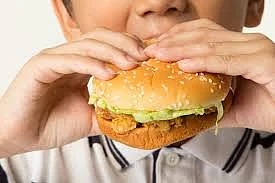A mere five minutes of exposure to junk food advertising is enough to make children eat an extra 130 calories in a day—roughly the equivalent of two slices of bread—regardless of the media platform, according to alarming new research presented at the European Congress on Obesity (ECO) 2024 in Málaga, Spain.
The study, led by Professor Emma Boyland from the University of Liverpool, is one of the most comprehensive trials to date examining the real-world impact of food marketing on youth eating habits.
It reveals that children aged 7 to 15 who viewed ads for foods high in fat, salt, and sugar (HFSS) consumed significantly more during snack and lunch times compared to when they saw non-food ads. Crucially, the calorie increase persisted across all ad formats—TV, podcasts, social media, and even static billboards.
“Even brief exposure to unhealthy food marketing can lead to excess calorie consumption and, over time, weight gain,” said Professor Boyland. “Our study highlights how deeply vulnerable young people are to food marketing—and how brand-only ads, not even showing food, can have the same damaging effect.”
One of the study라이브 바카라 most urgent findings is that "brand-only" advertising—ads that feature logos and branding but no food imagery—can be just as effective in increasing children's intake as product-focused ads. Yet, these brand-only promotions currently fall outside most advertising restrictions.
“This is a critical blind spot in global advertising policy,” Professor Boyland said calling for the urgent need for regulations that also target brand-only marketing, not just product images.
According to Professor Boyland: “Our results show that unhealthy food marketing leads to sustained increases in caloric intake in young people at a level sufficient to drive weight gain over time. This study is the first to demonstrate that brand-only food ads, for which there is currently no restrictive advertising policy globally, increase children라이브 바카라 food intake. This new knowledge will help in the design of urgent restrictive food marketing policies that can protect children라이브 바카라 health.”
In total, 240 UK children participated in the randomized crossover trial. Those with higher body mass indexes (BMIs) consumed even more extra calories in response to the ads, amplifying the concern that junk food marketing may widen existing health inequalities.
The evidence is clear: junk food ads are fueling excess consumption in children—and no platform is safe. Regulators must act swiftly to close loopholes, especially around brand-only ads, before another generation is shaped by food environments engineered for profit, not health.
In fact, this study lands alongside a growing body of alarming research on the health impacts of ultra-processed food consumption, which has now been linked to a wide range of serious conditions. In one such research, every additional 100 grams per day of ultra-processed food intake was associated with a 14.5% higher risk of hypertension, 5.9% increased risk of cardiovascular events, 1.2% rise in cancer risk, 19.5% greater risk of digestive diseases and 2.6% increase in all-cause mortality.
Presented at the ACC Asia 2025 the systematic review included 41 prospective cohort studies spanning the Americas, Europe, Asia and Oceania assessing the association between ultra-processed foods and health outcomes prior to April 2024. Taken together, the studies involved a total of 8,286,940 adult patients aged 18 years or older from the general population (30.8% male, 69.2% female).














